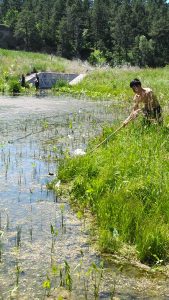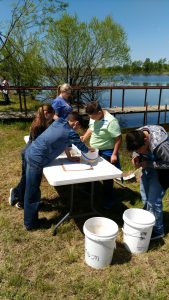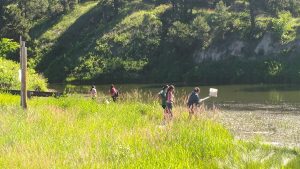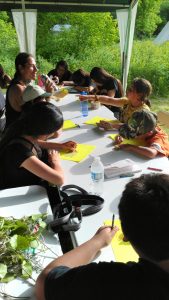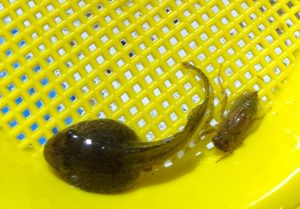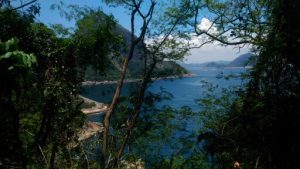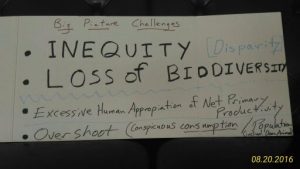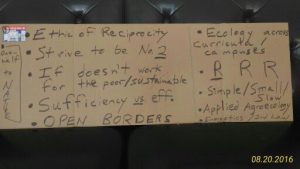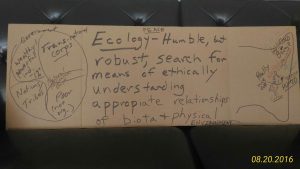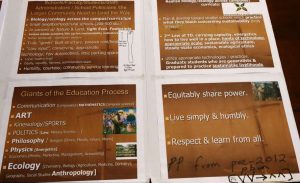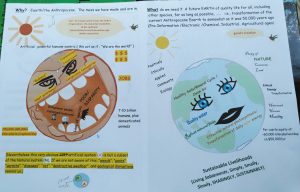“To live, we must daily break the body and shed the blood of Creation. When we do this knowingly, lovingly, skillfully, reverently, it is a sacrament. When we do it ignorantly, greedily, clumsily, destructively, it is a desecration. In such desecration we condemn ourselves to spiritual and moral loneliness, and others to want.” Wendell Berry, The Art of the Commonplace: The Agrarian Essays
…………………………..
• Earth (or now, Eaarth, per scholar Bill McKibben https://www.salon.com/2010/04/16/bill_mckibben_eaarth_interview_ext2010/ ) has limits because of innate characteristics of its ecosystem blocks of soil & air (biogeochemical cycles), water, amount of solar energy arriving each day, and biota it can sustain.
• We humans have overshot these limits in terms of human & domesticated species population numbers and especially through rampant consumption & development by the Haves.
• We humans are destroying the natural resource base and dynamic homeostatic symbioses (“nature”).
• There is tremendous disparity of power over natural resources and energy transformation. And this is a major causation of what is always immoral & and unethical–War.
The handwriting is on the wall! …
The real solution is living sabiamente (or wisely), simply, smally, slowly, steadfastly, sharingly, sustainably … and through the leveling off of human & domesticated animal numbers, reduction of human consumption & development by the Haves, and a sharing of power with havenots including other species. And we must educate, advocate, regulate toward ecological knowledge.
But not only knowledge. Along with this must come wisdom & prudence and a profound & holistic ethic of reciprocity. We need human populations that are practicing positively ethical applied community ecology (PEACE) across the Lands of Eaarth … and that will get Eaarth back to Earth.
……………………
Recently in the region of Seguin, Texas there is concern about the draining of several artificial lakes due to liability concerns about the integrity of the impoundment structures and potential risks to those who might be on the lakes should these structures fail (as was the case for two lakes “recently”). http://seguingazette.com/alert/article_0c55ee8c-7671-11e9-821f-af0dad2e52ba.html http://seguingazette.com/alert/article_e7b9582a-bf72-11e9-b73e-ff65a710dd97.html https://www.expressnews.com/news/local/article/GBRA-board-faces-backlash-from-residents-who-14366518.php
We know that directly or indirectly artificial lakes have provided and can continue to provide recreation, pleasing aesthetics, food, flood management, electricity, and irrigation & drinking water. However, through profound & holistic critical thinking and positively ethical applied community ecology, we also must consider the near & long-term effect of artificially impounding water on the social fabric and ecological community. https://www.internationalrivers.org/environmental-impacts-of-dams https://en.wikipedia.org/wiki/Environmental_impact_of_reservoirs
What are the whole-systems monetary, energetic, and material flow costs and benefits in maintaining these artificial lakes?
What does the disruption of nutrient & freshwater flow to the coastal bays & estuaries do to the biodiversity and integrity of these coastal ecosystems? What do artificial changes do to the watershed, wetlands, riparian areas, and littoral & benthic zones of the river or lake being considered, etc.?
There are many aspects to consider through: an ethic of reciprocity, considering the second law of thermodynamics and the precautionary principle, and employing critical thinking based on knowledge of ecological processes & principles.
pbm
[ 7 Ss / VV->^^ ]
